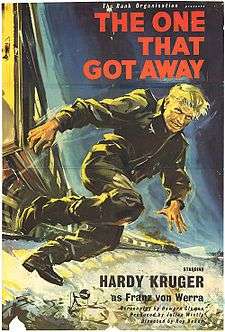The One That Got Away (film)
| The One That Got Away | |
|---|---|
|
theatrical poster | |
| Directed by | Roy Ward Baker |
| Produced by |
Julian Wintle Earl St. John |
| Written by | Howard Clewes |
| Based on |
the book The One That Got Away by Kendal Burt and James Leasor |
| Starring | Hardy Krüger |
| Music by | Hubert Clifford |
| Cinematography | Eric Cross |
| Edited by | Sidney Hayers |
Production company |
Julian Wintle Productions |
| Distributed by | Rank Organisation |
Release dates |
|
Running time | 111 minutes |
| Country | United Kingdom |
| Language | English |
| Box office | £3 million (Germany)[1] |
The One That Got Away is a 1957 Second World War film starring Hardy Krüger and featuring Michael Goodliffe, Jack Gwillim and Alec McCowen. The film was directed by Roy Ward Baker with a screenplay written by Howard Clewes, based on the 1956 book of the same name by Kendal Burt and James Leasor.
The film chronicles the true exploits of Oberleutnant Franz von Werra, a Luftwaffe pilot shot down over Britain in 1940. He initially tried to escape while captive in England, but was later successful during transfer to a Canadian POW camp.[2]
Plot
Luftwaffe fighter pilot Franz von Werra (Hardy Krüger) is shot down during the Battle of Britain and captured. He wagers with his RAF interrogator (Michael Goodliffe) at the POW reception centre, Air Defence Intelligence, Cockfosters, near Barnet in Hertfordshire, that he will escape within six months.
Initially, von Werra is sent to No 1 prisoner-of-war (POW) camp Grizedale Hall in the Furness area of Lancashire. His first escape attempt results in his recapture after an intense manhunt.
Subsequently, von Werra is sent to a more secure POW camp (based on the Hayes Conference Centre) near Swanwick, Derbyshire. He and four others escape through a tunnel. The others pair up, but von Werra continues alone. Reaching Codnor Park railway station, he impersonates a Dutch pilot and claims his Wellington bomber had crashed while on a secret mission. He telephones the nearest airfield, RAF Hucknall, and tricks the duty officer into sending a car. When his story starts to fray, von Werra creeps away and tries to steal an experimental Hawker Hurricane, only to be caught at the last moment.
Along with many other POWs, von Werra is sent by ship to Canada. On the train ride across the country, while the guards are distracted, he escapes near Smith's Falls, Ontario, by jumping from a window. Making his way south, von Werra crosses the nearly frozen St Lawrence River in a stolen rowboat and reaches Ogdensburg, New York, in the then still-neutral United States to claim asylum. The RAF interrogator receives a postcard from von Werra featuring a photograph of the Statue of Liberty, informing him that he has lost his bet.
The epilogue states:
Despite the efforts of the Canadian Government to obtain his return, and of the United States Authorities to hold him, von Werra crossed the border into Mexico. Travelling by way of Peru, Bolivia, Brazil and Spain, he reached Berlin on 18 April 1941.
On 25 October of the same year, while on patrol, his plane was seen to dive into the sea. No trace of von Werra was found.
Cast
|
|
Production
Kenneth More says he was approached to play the lead role but turned it down as he had just played another real-life POW, Douglas Bader in Reach for the Sky (1956).[3] John David, head of the Rank organisation, wanted Dirk Bogarde. Director Roy Baker insisted on a German.[1] O.W. Fischer was reportedly considered for the lead, then disregarded as he was too old. Rank's overseas distribution manager then suggested Hardy Krüger.[4]
A Messerschmitt Bf 109 and Hawker Hurricane were featured in the production. As of 2014, the Hawker Hurricane IIc (serial number LF363) is still in existence, flying with the Battle of Britain Memorial Flight.[5]
Reception
The One That Got Away was generally well received by audiences and critics; Howard H. Thompson of The New York Times noted its "... restrained, well-knit scenario."[6]
The film was popular in Britain and did extremely well in Germany, making over £3 million. It made a comfortable profit.[1]
This prompted producer Julian Wintle to form his own production company and he made two films with German protagonists, Bachelor of Hearts (also starring Krüger) and Tiger Bay.[1]
See also
References
Notes
- 1 2 3 4 British Cinema of the 1950s: The Decline of Deference by Sue Harper, Vincent Porter Oxford University Press, 2003 p 47
- ↑ Erickson, Hal. "The One That Got Away (1957)." The New York Times. Retrieved: 6 May 2012.
- ↑ More 1978, p. 171.
- ↑ "The most explosive object to hit Britain since the V2!": The British Films of Hardy Krüger and Anglo-German Relations during the 1950s Williams, Melanie. Cinema Journal46.1 (Fall 2006): 85-107
- ↑ "Hurricane LF363 (Mk IIc)." RAF BBMF. Retrieved: 12 July 2012.
- ↑ Thompson, Howard H. "The One That Got Away (1957): Escape Drama Opens." The New York Times, 23 April 1958.
Bibliography
- Evans, Alun. Brassey's Guide to War Films. Dulles, Virginia: Potomac Books, 2000. ISBN 1-57488-263-5.
- More, Kenneth. More or Less. London: Hodder & Staughton, 1978. ISBN 978-0-340-22603-2.
External links
- The One That Got Away at the Internet Movie Database
- The One That Got Away at the TCM Movie Database
- The One That Got Away at AllMovie
- The One That Got Away (book) by James Leasor, 1956, 2011. ISBN 978-1-908291-12-7
- The One That Got Away (film) Internet Archive
